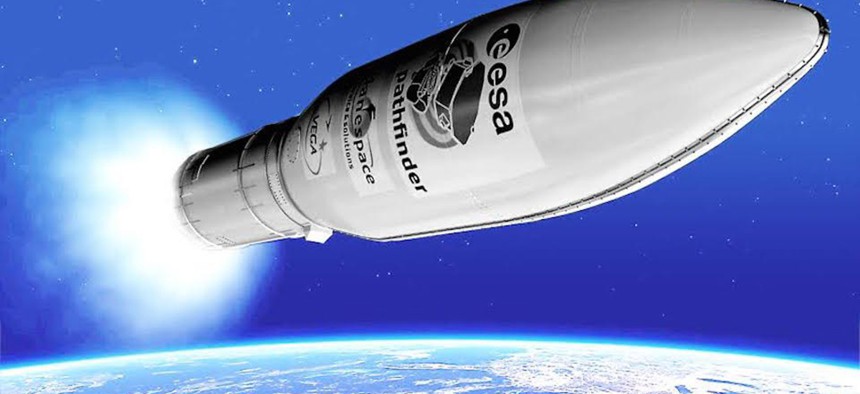Satellites That Could Trace the Ripples of the Cosmos

eLISA Science / The Atlantic
The eLISA space mission aims to detect gravitational waves with an enormous laser triangle and floating gold cubes.
Over the course of this series, we’ve seen multiple examples of the outsize roles satellites play in both political and planetary science, with their cameras and other delicate sensors trained down upon the Earth from above. But turning them to face the other way—looking out into deep space, beyond the limits of our own galaxy, even to the very edge of the known universe—can often be far more imaginatively stimulating.
The Evolved Laser Interferometer Space Antenna, or eLISA, is easily one of the most interesting offworld scientific experiments underway today. eLISA relies upon a stable configuration of three discrete satellites. Each craft is separated by a gap of 1 million kilometers, or roughly 621,000 miles, arranged to form the vertices of an enormous equilateral triangle in space. The lines connecting this titanic piece of interstellar geometry are drawn, point to point, by laser beams.
Strangest of all, however, within each satellite there is a set of tiny gold cubes that will free-float in zero gravity. These are referred to as “free falling test masses,” and they are there to help detect even the smallest disturbance in the fabric of spacetime. They are looking for gravitational waves.
Gravitational waves can be thought of as ripples on the surface of a cosmic pond: they are waves created billions of years ago by the collision of two black holes. These extraordinarily ancient collisions, from the earliest years of the universe, mean that gravitational waves themselves are almost mind-bogglingly old. They are remnant spacetime structures that have, in a sense, been sloshing around the cosmos, bearing traces of primordial events. And until 2015, they had eluded human detection.
The news announced earlier this year that LIGO—the Laser Interferometer Gravitational-Wave Observatory—had successfully detected gravitational waves set off a burst of excitement in the world of astrophysics. By allowing us to “see” gravitational waves—where “seeing” is purely a metaphor, as it is actually much closer to “hearing” their tiny vibrations—tools such as LIGO promise to open an entirely new type of astronomy.
The birth of gravitational-wave astronomy is at least loosely analogous to a move from studying visible light to radio waves, or it could be compared to discovering an entirely new spectrum beyond infrared. In other words, previously hidden structures and events, objects and systems, have now become detectable.
With the help of gravitational-wave astronomy, the theory goes, we will soon wake up to the fact that all along the universe has been pinging and rolling like a vast sea, crisscrossed by minute waves in spacetime, endlessly and wonderfully dynamic with forces that were once mere speculation.
eLISA—the giant equilateral triangle in space—can be described as LIGO in space. It is an even larger tool, however, and it will operate with significantly less ambient disturbance. LIGO engineers, for example, had to tune-out everything from wolf calls to truck traffic so that their earthbound instrument did not inadvertently mistake terrestrial background noise for ghostly waves of ancient spacetime.
By moving out into the vacuum of space, eLISA should offer gravitational sensitivities beyond anything possible here on Earth—and, in the process, this satellite-based observatory could produce a much clearer, more all-encompassing portrait of the intricacies of spacetime.
This ability to take our instruments not just above the clouds but off the Earth entirely—expanding our eyes and ears to form a kind of interplanetary sensorium—gives the human species a whole new way both to sense and to understand the cosmos.
What also interests me here, however, is the fact that a technical instrument or scientific tool, whether it’s eLISA or LIGO, can begin to sound more like a magical device from medieval folklore—these golden cubes floating in an equilateral triangle, each side three times larger than the distance from the Earth to the moon, shivering in tune with the subtlest pulsations of the universe.
But any undertaking of this sensitivity, dealing with forces so alien to everyday human experience, will necessarily overlap with narratives more comparable to mythology or, at the very least, to science fiction.
Consider a remark from Kip Thorne, one of LIGO’s original theorists and designers. While speaking with The New Yorker earlier this year, and attempting to describe the stakes of gravitational-wave astronomy, Thorne used an analogy almost H.P. Lovecraftian in its implications.
“We are opening up a window on the universe,” he said, “so radically different from all previous windows that we are pretty ignorant about what’s going to come through. There are just bound to be big surprises.”
By upping both the scale of observation and the available sensitivity, eLISA promises to expand Thorne’s metaphor to something much larger, perhaps more like a door, one radically different from all previous doors. Wonderfully, we still don’t know what the act of opening it will reveal.


